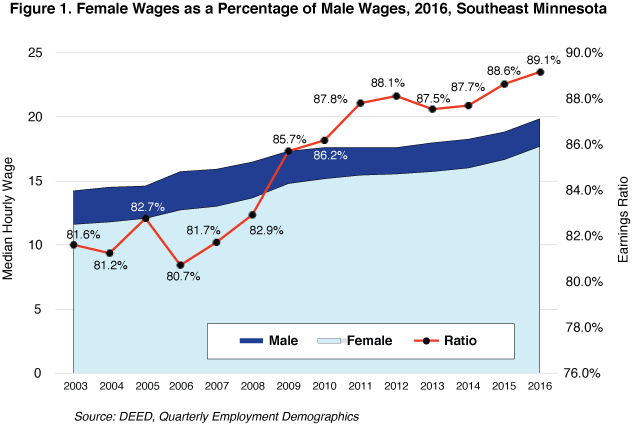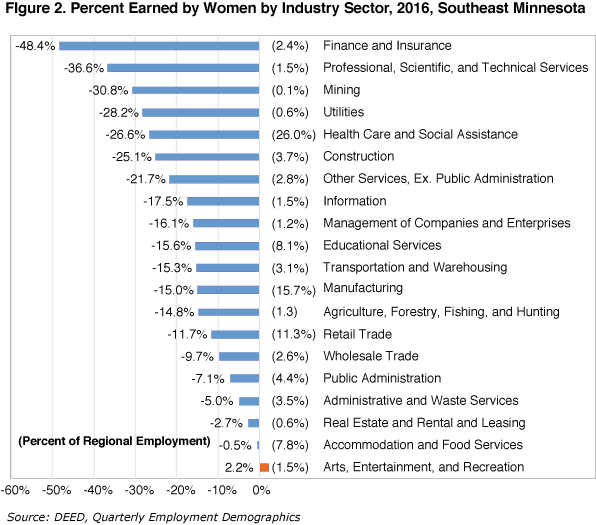by Mark Schultz
February 2018
Gender equality is not a new idea, with efforts being made to bring about equality in educational, social, economic, religious, and political realms. From women's gaining suffrage in 1920 to current efforts made by groups such as the American Association of University Women who seek to "advance equity for women and girls through advocacy, education, philanthropy, and research," progress is being made. However, areas still exist in which women face barriers to equality. One such area is wages paid for work performed.
In 1963 the Equal Pay Act was passed which "prohibits sex-based wage discrimination between men and women in the same establishment who perform jobs that require substantially equal skill, effort, and responsibility under similar working conditions". However, there is still a gender pay gap across all states. According to research conducted by the American Association of University Women, Minnesota ranks 12th in the nation with the earnings ratio for men and women at 83 percent. That is to say that women were paid 83 percent of what their male counterparts were earning for full-time, year-round employment.
According to data from DEED's Quarterly Employment Demographics, Southeast Minnesota is not exempt from this earnings pitfall. However, while the most recent data show that the region's gender pay ratio sat at 89.1 percent, meaning that women were making 89.1 percent of what men were across all industries, this is higher than the pay ratio of the state as a whole, which was almost five percentage points lower at 84.4 percent.
As shown in Figure 1, median hourly wages across all industries were $19.81 for men and $17.66 for women in Southeast Minnesota. However, certain things need to be considered when examining data on the gender pay gap and wages earned. One of the biggest questions about the analysis of wage earnings by gender is connected to the type of work that is being performed. For instance, according to DEED's Quarterly Employment Demographics (QED) data, within the professional and business services industry supersector a higher percentage of women (59.7 percent) work in jobs that are part of the professional and technical services industry sector earning a median hourly wage of $17.32. Within that same industry supersector there is a higher percentage of males (56.4 percent) earning $25.76 as a median wage working in jobs within the management of companies and enterprises sector. Because QED data is industry-based, not occupation-based, the wages can vary greatly by the occupation of the individual within an industry.
 2
2
There is evidence that type of job matters, though, as seen in the listings of non-traditional careers for men and women. This list shows that for the non-traditional careers for women, median wages range from $10.01 to $88.38 whereas the median wages for non-traditional careers for men only range from $9.97 to $35.26. Additionally, in the list of non-traditional careers for women there are 52 occupations that earn $25 or more per hour, whereas there are only 11 in the list for non-traditional careers for men.
Choice of occupation is a personal decision that also plays a role in subsequent wage differentials between men and women in the region. For example, law enforcement is a male-dominated occupation in Minnesota according to the Minnesota Board of Peace Officer Standards and Training, showing that of the 10,918 peace officers in the state, both full-time and part-time, 88.3 percent are men. On the other hand, the Minnesota Department of Health shows that about 88 percent of licensed social workers are women. When looking at the wages of these two occupations, police officers earn a median hourly wage of $28.36 while social workers make $22.12 for a median wage.
What is promising, though, is that the ratio has seen a fairly steady increase since 2003, meaning that the pay gap between men and women has been narrowing in the region. In fact, the region saw a huge increase in female wages over time and now has a smaller percentage gap and a faster increase in female wages than the state as a whole.
| Table 1. Difference in Male and Female Hours Worked per Quarter, Southeast Minnesota | ||||
|---|---|---|---|---|
| Industry | Male | Female | Hour Difference | Percent Difference |
| Total, All Industries | 480 | 407 | 73 | 15.2% |
| Agriculture, Forestry, Fishing, and Hunting | 478 | 260 | 218 | 45.6% |
| Mining | 450 | 397 | 53 | 11.8% |
| Utilities | 533 | 528 | 5 | 0.9% |
| Construction | 490 | 472 | 18 | 3.7% |
| Manufacturing | 529 | 520 | 9 | 1.7% |
| Wholesale Trade | 520 | 505 | 15 | 2.9% |
| Retail Trade | 336 | 227 | 109 | 32.4% |
| Transportation and Warehousing | 444 | 411 | 33 | 7.4% |
| Information | 528 | 497 | 31 | 5.9% |
| Finance and Insurance | 520 | 514 | 6 | 1.2% |
| Real Estate and Rental and Leasing | 312 | 320 | -8 | -2.6% |
| Professional and Technical Services | 494 | 438 | 56 | 11.3% |
| Management of Companies and Enterprises | 520 | 520 | 0 | 0.0% |
| Administrative and Waste Services | 258 | 204 | 54 | 20.9% |
| Educational Services | 346 | 264 | 82 | 23.7% |
| Health Care and Social Assistance | 480 | 455 | 25 | 5.2% |
| Arts, Entertainment, and Recreation | 237 | 127 | 110 | 46.4% |
| Accommodation and Food Services | 193 | 157 | 36 | 18.7% |
| Other Services, Ex. Public Administration | 252 | 167 | 85 | 33.7% |
| Public Administration | 483 | 480 | 3 | 0.6% |
| Source: DEED Quarterly Employment Demographics | ||||
Still, complicating the issue is that women appear to be working fewer hours than their male counterparts. According to Quarterly Employment Demographics data, the median hours that women worked across all industries was 407 per quarter in 2016, while males worked 480. Thus, women may be hit with a double-whammy of being paid less and working fewer hours. To put that into context, if a man is making $19.81 per hour and working 480 hours a quarter and a woman is making $17.66 per hour (89.1 percent of the male) at 407 hours per quarter, the quarterly difference is $2,321 in wages or almost $9,300 annually.
The data also show that the trend of women working fewer hours per quarter than men exists across major industry sectors with the exception of Real Estate and Rental and Leasing where women worked a median eight more hours per quarter, and Management of Companies and Enterprises in which both men and women worked a median of 520 hours per quarter. However, there are large differences in the median number of hours worked in the other industry sectors. For example, while the median number of hours worked by women was only three hours less per quarter in the Public Administration sector, the female median was 218 less hours than their male counterparts in Agriculture, Forestry, Fishing, and Hunting.
When broken down by industry sector, the data show that there is significant variation in the amount less that females make compared to males, with women making only slightly more in Arts, Entertainment, and Recreation. As shown in Figure 2, women made anywhere from 0.5 percent to 48.4 percent less than men in all but one industry sector, with the greatest difference in Finance and Insurance, followed by 36.6 percent less in Professional, Scientific and Technical Services, and 30.8 percent less in Mining.

Again, in these cases it is entirely possible that choice of occupation within the industry plays a role in these wage differences. For example, it is possible that some of the wage gap in Finance and Insurance could be caused by more females taking jobs as bank tellers, who currently earn an hourly median wage of $14.34, versus more males working as securities, commodities, and financial services sales agents, who earn $30.22 for a median wage in Southeast Minnesota.
And while there is one sector in which women earned more than men – Arts, Entertainment, and Recreation – this figure is a bit misleading as overall they still made less when considering the number of hours each gender worked. The data show that women indeed have a higher median hourly wage than men at $13.76 compared to $13.46. However, men had a higher median quarterly hours worked of 237 compared to 127 for women. When both are taken into consideration that equals a quarterly median earnings of $3,190 for men and only $1,747 for women.
Without a doubt there is a pay gap in wages between men and women in the Southeast region, although the data show that this gap is narrowing. There are many implications of this analysis that are worth noting and exploring further, such as: